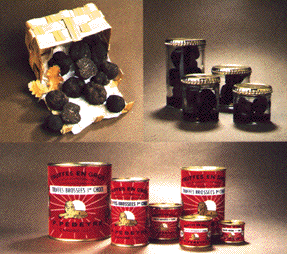
|
The truffle in all of its states
If our art is about good buying, our work is also about good preparation.
Bought "in earth" at the markets, the truffles are carefully
washed and brushed before being sorted. During the operation they lose
between 15 to 20% of their weight. All of the truffles go through three
successive sortings before being sold.
THE FRESH TRUFFLE
The fresh brushed truffles which we dispatch fron November to March have
to be rapdly handled on reception. They are put into small chestnuts
baskets to enable the mushrooms to breathe.
The orders are recorded by telephone or by telex.
We may be contacted for enquiries as to market trends and to obtain a firm
price..
TINNED TRUFFLE
Tinned after the first boilin:
Tinned while fresh, the truffle undergoes a sterilization procedure which
makes a normal tinned product. However this first sterilization makes it
lose about 25% of its substance, which becomes truffle juice. This varying
loss, which does not allow, when the tin is opened, for a net weight of
cooked truffles, limits selling to professional buyers.
Tinned after normal cooking:
The truffle thus tinned undergoes two sterilizations. The first, carried
out in large cans, boils off its juice. The second sterilization takes
place when the truffles have been sorted a fourth and final time and
repackaged in little tins. At this stage part of the juice lost in the
first cooking is added; the rest is sold as truffle juice. This double
operation permits ensuring a net weight of cooked truffles when the tins
are opened..
|

